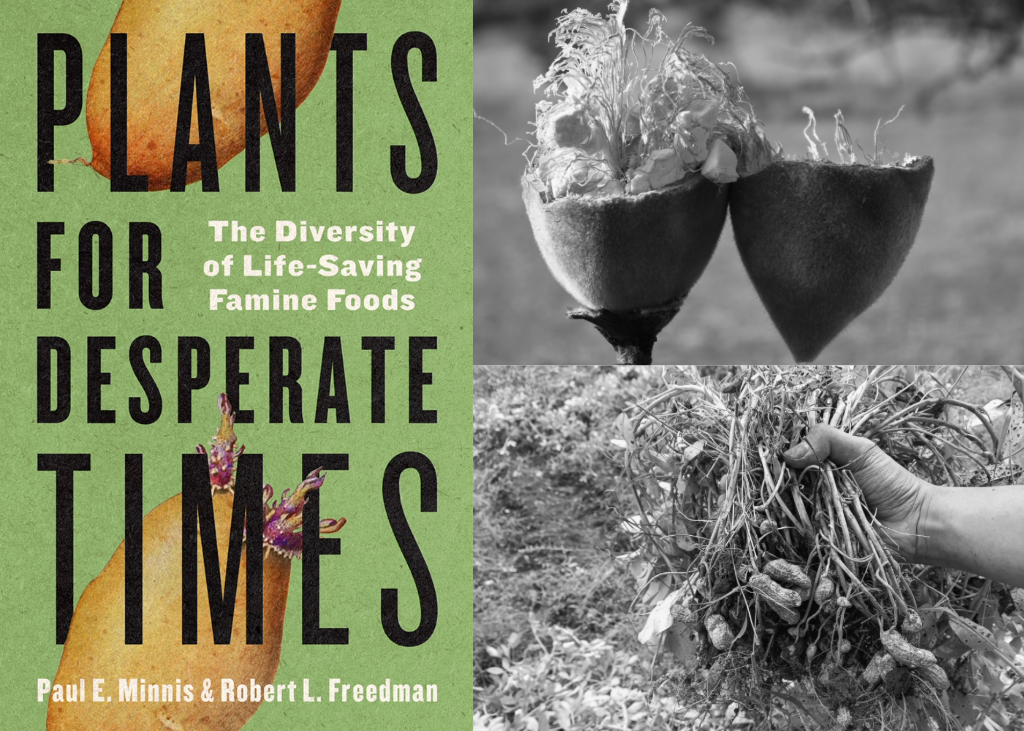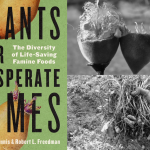October 31, 2024
Plants for Desperate Times: The Diversity of Life-Saving Famine Foods, by Paul E. Minnis and Robert L. Freedman, is an introduction to the diversity of plant foods that have saved millions of lives during lethal food shortages. While not a field guide, it addresses questions about what famine foods are and why they are important. The work highlights one hundred plants. Each entry includes the common and scientific names, botanical family, distribution, use as a famine food and other uses, and nutritional information. The species come from across the botanical kingdom, demonstrating the diversity of life-saving plants and the human ingenuity of making what might seem to be inedible plants edible. Unexpectedly, important famine foods include alternative uses of important crops as well as native plants.
Beyond a study of famine foods, the authors share why keeping an inventory of plant foods of last resort is so important. They help to build an understanding of little-known and underappreciated foods that may have a greater role in provisioning humanity in the future. As much as we may hope that severe food scarcity will never occur again, history suggests otherwise, and Plants for Desperate Times provides invaluable documentation of these vital foods. Read an excerpt from the book’s first chapter below.
Severe food shortages have been one of the ever-present Four Horsemen of the Apocalypse. We know of no part of the world where lethal food shortages have been absent. And famines have been all too frequent: thousands have been noted in historical records. Now, consider yourself and your ancestors. Had only one of your many direct lineal ancestors going back multiple generations not survived a severe food shortage before reproducing, you would not exist. Fortunately, one of the many ways to survive starvation has been the consumption of famine foods, many of which are plants. In short, nearly all of us likely owe our very existence to these unappreciated plants.
The value of famine foods extends far beyond our individual existence. The sum total of deaths due to severe food shortages throughout history surely is in the hundreds of millions. One study estimated that seventy-five million died during famines in the twentieth century alone. Millions can perish in a single episode due to mass starvation and associated diseases. The most famous famine, the An Gorta Mór or Irish Potato Famine of the 1840s, led to around one million deaths as well as massive emigration. Parts of the Soviet Union in the mid-1930s witnessed horrendous starvation and suffering. It has been estimated that the Ukrainian famine (Holodomor) resulted in more than four million deaths, while the toll of starvation deaths in the North Caucuses and Upper Volga regions was two to three million, and Kazakhstan suffered 1.5 to 2.3 million deaths all at about the same time. The Chinese famine during the Great Leap Forward in the mid-twentieth century resulted in fifteen to thirty-three million or more deaths, probably the most lethal famine on record.
The effects of severe food shortages are far more than immediate starvation and death. There are often long-term, multigenerational health effects from starvation. Famines have psychological, social, demographic, and even genetic consequences. Irish society was altered for decades after the potato famine because of the scale of death and emigration. The Kazakh famine contributed to the permanent destruction of the traditional Kazakh herding economy and led to ethnic Kazakhs being a minority in their country until the 1990s.
What Are Famine Foods?
The common image of a famine food is of a little-used and perhaps even despised native plant eaten only during the most desperate times. There is in fact no universal definition of a famine food. In general, there are two views of what famine foods are. The most common term is restricted to those foods not normally eaten but are eaten only during food shortages. An alternative and broader definition is they are foods eaten during food shortages. The latter, broader category can include foods normally eaten but that are consumed in novel ways or in unusual quantities during shortages. Eating cultivated grains or fruits before maturity or increasing the consumption of wild plants that would normally be minor components of the diet are examples of this more expansive view of famine foods, the definition we will use here. For example, in a study in southern Ethiopia, the authors found that of the many wild food plants consumed during shortages, three-fourths were eaten in both times of normal rations and during food shortages, and only a quarter of the species were eaten only during times of food stress. Therefore, focusing simply on plants consumed only during shortages restricts our understanding of how people use plants to feed themselves when food stores are low or absent.
Likewise, the foods discussed here are not restricted to those consumed during famines, the most acute food shortages. There is a range of food shortages. At one end of a continuum of food shortage severity are annual hunger seasons. A hunger season is often anticipated as a time in the normal yearly cycle when food stocks are low. This is common when stored foods are depleted and before harvest, or at the end of a dry season before vegetation grows with the monsoons. At the other end of the continuum are actual famines. In between are a range of food shortages of varying severity but not as catastrophic as famines. Whatever the severity of the food shortage, humans have employed their ingenuity to cope with such events. Among the many strategies used is the consumption of foods not normally eaten or eaten in novel ways. Knowledge of famine foods is a part of traditional ecological knowledge (TEK), quite often gained through centuries if not millennia of intimate and intense interaction with the environment. This information has value for helping during modern food shortages.
Why Are Famine Foods Important?
Regrettably, the study of famine foods has been an infinitesimally small niche of food scholarship. Literally thousands of books view food in other ways. Most often, it seems, we read about food as a sensory pleasure, as a focal point of social interaction, as a key component of cultural identity, and as a means to consume an optimal diet. These are all important ways of viewing food. By contrast, it is surprising how little academic and practical attention has been given to famine foods in light of how important these plants have been to humanity’s very existence.
This is unfortunate because the study of famine foods is not simply an obscure academic topic. Because we cannot predict the future with precision, we should prepare for contingencies. It should be obvious that knowledge of famine foods could help ameliorate the effects of food shortages in the future. Famine foods may not be the best tasting, the most nutritious, the most efficient to collect, or the easiest to prepare, but they can help keep people alive, the minimal and essential value of food.
There is a long history of organizations and individuals working to maintain the genetic diversity of poorly known or even nearly extinct crops and crop varieties. The Svalbard Seed Vault (“Doomsday Seed Bank”) in far northern Norway is only the most recent and well-publicized of the many genetic repositories around the world, including dozens in the United States. The concern about preserving the genome of crops has not extended to famine foods. There are famine foods, some of which are highlighted in this volume, that have the potential for greater use because of their favorable nutritional profile. Plants used as famine foods, almost by definition, are some of the most resilient food resources because they have to be available when other foods aren’t. Food resilience is a powerful characteristic when faced with an uncertain and dynamic future.
 The University of Arizona Press
The University of Arizona Press


